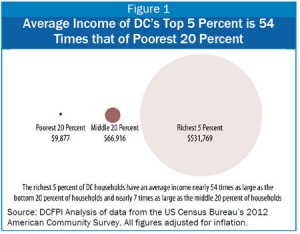The District of Columbia has one of the highest levels of income inequality in the country. The average income of the top 5 percent of District households is 54 times the income of the bottom 20 percent, the fourth highest level of income inequality among the 50 largest U.S. cities.[1]
There are two main reasons why income inequality in the District remains so high:
- The average income for the District’s top 5 percent of households is now over half a million dollars, the highest among large U.S. cities.[2] In
 2011, the average income of the top 5 percent of DC households exceeded $500,000 for the first time. By 2012, the average income of this group reached $530,000. DC is one of only three cities where the average income of the wealthiest 5 percent is above $500,000. The average income for DC’s wealthiest 20 percent ‘$284,000 ‘ is also among the highest in the country, second only to San Francisco.
2011, the average income of the top 5 percent of DC households exceeded $500,000 for the first time. By 2012, the average income of this group reached $530,000. DC is one of only three cities where the average income of the wealthiest 5 percent is above $500,000. The average income for DC’s wealthiest 20 percent ‘$284,000 ‘ is also among the highest in the country, second only to San Francisco.
- The average income of the bottom fifth of DC households is just $9,900. Although DC has one of the highest costs of living among large cities, the average income of our poorest households is roughly average compared with other large cities. This income covers just 12 percent of the basic family budget ($85,000) for a single parent with two children ‘ the ninth worst when compared with other large cities.
This paper uses data from the U.S. Census Bureau’s American Community Survey from 2006 through 2012 to examine income disparities in DC and the 49 other largest cities. (See Appendix A for complete list of cities.).[3]
[1] U.S. Census Bureau. Annual Estimates of the Resident Population for Incorporated Places Over 50,000, Ranked by July 1, 2012 Population: April 1, 2010 to July 1, 2012. May 2013.
[2] The American Community Survey measure of income does not include in-kind transfers received by low-income households such housing vouchers or food stamps. While the measure includes dividends, interest, and other types of unearned cash income, it does not include non-cash capital gains.
[3] The 50 largest cities by population includes three Census jurisdictions that include larger metropolitan government entities. These are Louisville/Jefferson County Metropolitan Government, Nashville-Davidson Metropolitan Government, and Indianapolis.
